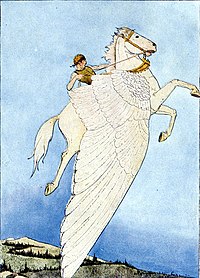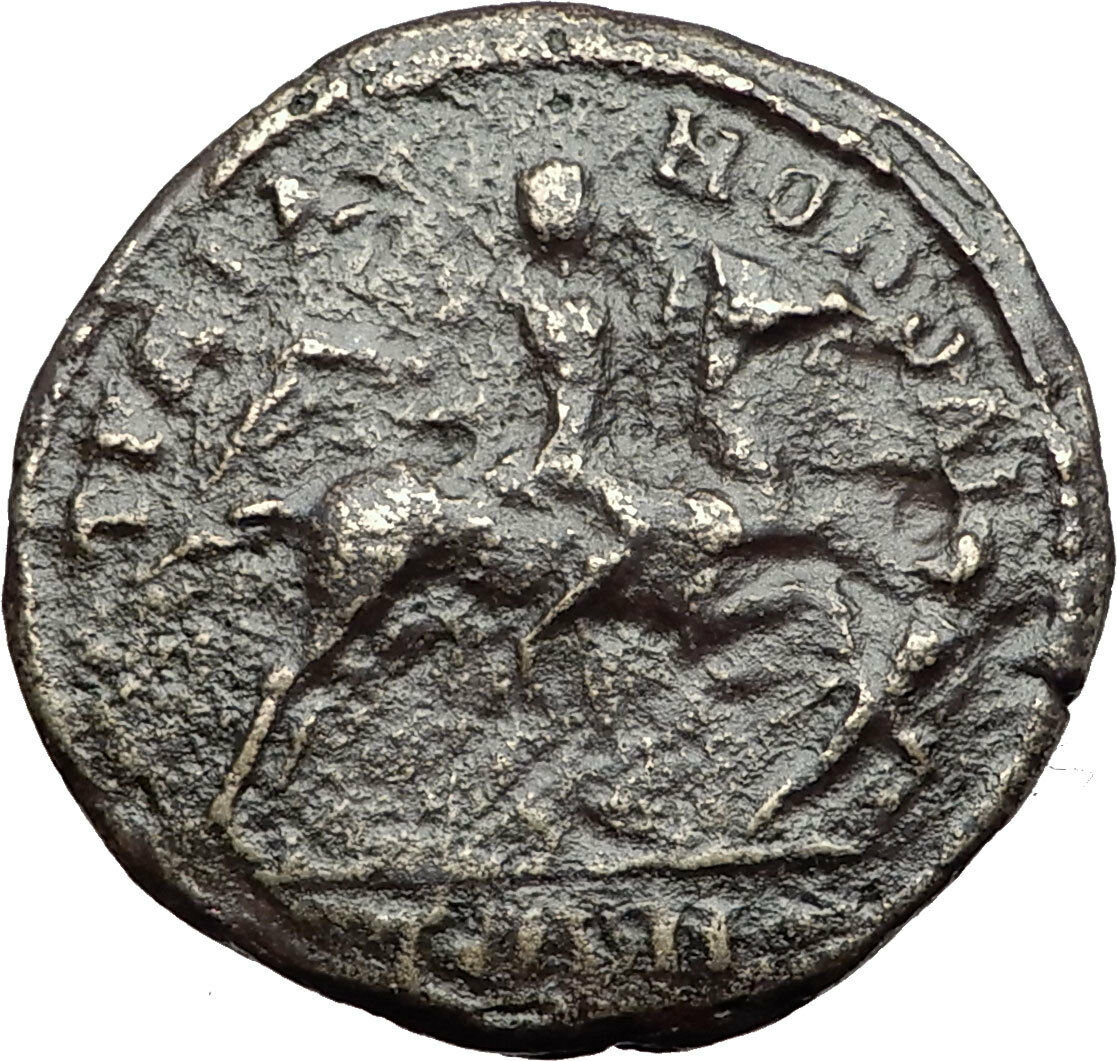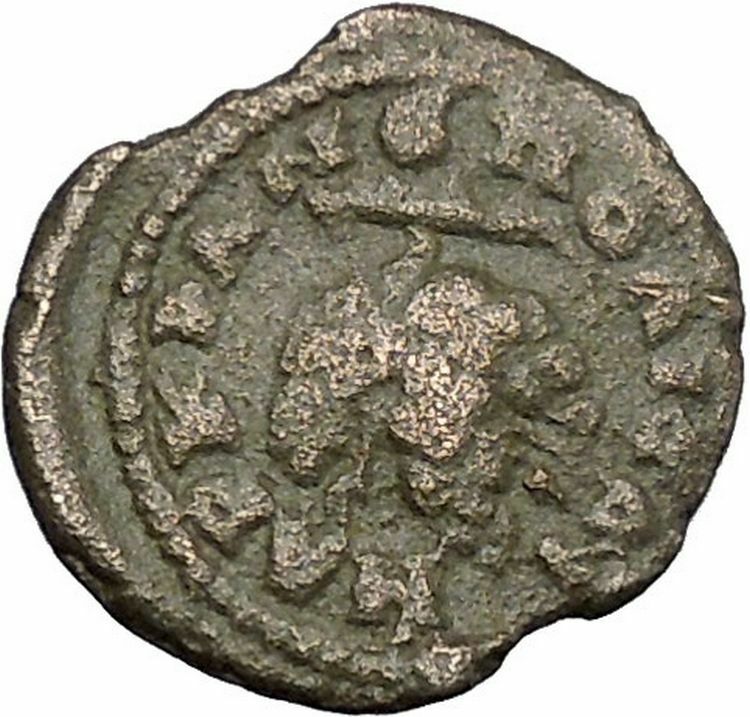|
Philip I ‘the Arab’ – Roman Emperor: 244-249 A.D.
Bronze 31mm (21.19 grams) of Samosata in Commagene
Reference: Sear GIC 3953 var. (reverse inscription)
AYTOK. K. M. IOVΛI. ΦIΛIΠΠOC CЄB, Laureate, draped and cuirassed bust right.
ΦΛ. CAMOCATЄWN MHTPOΠ. KOM., City-goddess (Tyche) seated left on rock, holding ears of corn, eagle on right arm; beneath, Pegasus flying left.
You are bidding on the exact item pictured, provided with a Certificate of Authenticity and Lifetime Guarantee of Authenticity.
 Tyche (meaning “luck”; Roman equivalent: Fortuna) was the presiding tutelary deity that governed the fortune and prosperity of a city, its destiny. She is the daughter of Aphrodite and Zeus or Hermes. Tyche (meaning “luck”; Roman equivalent: Fortuna) was the presiding tutelary deity that governed the fortune and prosperity of a city, its destiny. She is the daughter of Aphrodite and Zeus or Hermes.
In literature, she might be given various genealogies, as a daughter of Hermes and Aphrodite, or considered as one of the Oceanids, daughters of Oceanus and Tethys, or of Zeus. She was connected with Nemesis and Agathos Daimon (“good spirit”).
The Greek historian Polybius believed that when no cause can be discovered to events such as floods, droughts, frosts or even in politics, then the cause of these events may be fairly attributed to Tyche.
Worship
Increasingly during the Hellenistic period, cities venerated their own specific iconic version of Tyche, wearing a mural crown (a crown like the walls of the city).
Tyche had temples at Caesarea Maritima, Antioch, Alexandria and Constantinople. In Alexandria the Tychaeon, the temple of Tyche, was described by Libanius as one of the most magnificent of the entire Hellenistic world.
She was uniquely venerated at Itanos in Crete, as Tyche Protogeneia, linked with the Athenian Protogeneia (“firstborn”), daughter of Erechtheus, whose self-sacrifice saved the city.
Stylianos Spyridakis concisely expressed Tyche’s appeal in a Hellenistic world of arbitrary violence and unmeaning reverses: “In the turbulent years of the Epigoni of Alexander, an awareness of the instability of human affairs led people to believe that Tyche, the blind mistress of Fortune, governed mankind with an inconstancy which explained the vicissitudes of the time.”
Depictions
Tyche appears on many coins of the Hellenistic period in the three centuries before the Christian era, especially from cities in the Aegean. Unpredictable turns of fortune drive the complicated plotlines of Hellenistic romances, such as Leucippe and Clitophon or Daphnis and Chloe. She experienced a resurgence in another era of uneasy change, the final days of publicly sanctioned Paganism, between the late-fourth-century emperors Julian and Theodosius I who definitively closed the temples. The effectiveness of her capricious power even achieved respectability in philosophical circles during that generation, though among poets it was a commonplace to revile her for a fickle harlot.
In medieval art, she was depicted as carrying a cornucopia, an emblematic ship’s rudder, and the wheel of fortune, or she may stand on the wheel, presiding over the entire circle of fate.
The constellation of Virgo is sometimes identified as the heavenly figure of Tyche, as well as other goddesses such as Demeter and Astraea.
 Pegasus is one of the best known fantastical creatures in Greek mythology. He is a winged divine horse, usually white in color. He was sired by Poseidon, in his role as horse-god, and foaled by the Gorgon Medusa. He was the brother of Chrysaor, born at a single birthing when his mother was decapitated by Perseus. Greco-Roman poets write about his ascent to heaven after his birth and his obeisance to Zeus, king of the gods, who instructed him to bring lightning and thunder from Olympus. Friend of the Muses, Pegasus is the creator of Hippocrene, the fountain on Mt. Helicon. He was captured by the Greek hero Bellerophon near the fountain Peirene with the help of Athena and Poseidon. Pegasus allows the hero to ride him to defeat a monster, the Chimera, before realizing many other exploits. His rider, however, falls off his back trying to reach Mount Olympus. Zeus transformed him into the constellation Pegasus and placed him in the sky. Pegasus is one of the best known fantastical creatures in Greek mythology. He is a winged divine horse, usually white in color. He was sired by Poseidon, in his role as horse-god, and foaled by the Gorgon Medusa. He was the brother of Chrysaor, born at a single birthing when his mother was decapitated by Perseus. Greco-Roman poets write about his ascent to heaven after his birth and his obeisance to Zeus, king of the gods, who instructed him to bring lightning and thunder from Olympus. Friend of the Muses, Pegasus is the creator of Hippocrene, the fountain on Mt. Helicon. He was captured by the Greek hero Bellerophon near the fountain Peirene with the help of Athena and Poseidon. Pegasus allows the hero to ride him to defeat a monster, the Chimera, before realizing many other exploits. His rider, however, falls off his back trying to reach Mount Olympus. Zeus transformed him into the constellation Pegasus and placed him in the sky.
Hypotheses have been proposed regarding its relationship with the Muses, the gods Athena, Poseidon, Zeus, Apollo, and the hero Perseus.
The symbolism of Pegasus varies with time. Symbol of wisdom and especially of fame from the Middle Ages until the Renaissance, he became one symbol of the poetry and the creator of sources in which the poets come to draw inspiration, particularly in the 19th century. Pegasus is the subject of a very rich iconography, especially through the ancient Greek pottery and paintings and sculptures of the Renaissance. Personification of the water, solar myth, or shaman mount, Carl Jung and his followers have seen in Pegasus a profound symbolic esoteric in relation to the spiritual energy that allows to access to the realm of the gods on Mount Olympus.
In the 20th and 21st century, he appeared in movies, in fantasy, in video games and in role play, where by extension, the term Pegasus is often used to refer to any winged horse.
 Philip I ‘the Arab’ – Emperor: 244-249 A.D. Philip I ‘the Arab’ – Emperor: 244-249 A.D.
Augustus: 244-249 A.D. | 244-247 A.D. (Sole Reign) | 247-249 A.D. (with Philip II) |
| Husband of Otacilia Severa | Father of Philip II | Son of Julius Marinus |
Marcus Julius Philippus or Philippus I Arabs (c. 204-249), known in English as Philip the Arab or formerly (prior to World War II) in English as Philip the Arabian, was a Roman Emperor from 244 to 249.
Little is known about Philip’s early life and political career. He was born in Shahba, about 55 miles southeast of Damascus, in the Roman province of Syria. Philip has the nickname “the Arab” because he had family who had originated in the Arabian peninsula, believed to be distant descendants of the prestigious Baleed family of Aleppo. Philip was the son of a Julius Marinus, a local Roman citizen, possibly of some importance. Many historians agree that he was of Arab descent who gained Roman citizenship through his father, a man of considerable influence. Many citizens from the provinces took Roman names upon acquiring citizenship. This makes tracing his Arabic blood line difficult. However, it is documented that Rome used the Ghassan tribe from the Azd of Yemen as vassals to keep the neighboring northern Arabs in check.
The name of Philip’s mother is unknown, but sources refer to a brother, Gaius Julius Priscus, a member of the Praetorian guard under Gordian III (238-244). In 234, Philip married Marcia Otacilia Severa, daughter of a Roman Governor. They had two children: a son named Marcus Julius Philippus Severus (Philippus II) in 238 and according to numismatic evidence they had a daughter called Julia Severa or Severina, whom the ancient Roman sources don’t mention.
Philip became a member of the Pretorian Guard during the reign of the emperor Alexander Severus, who was a Syrian. In ancient Rome the Pretorian Guard was closely associated with the emperor, serving among other things as the emperor’s bodyguard.
Political career
In 243, during Gordian III’s campaign against Shapur I of Persia, the Praetorian prefect Timesitheus died under unclear circumstances. At the suggestion of his brother Priscus, Philip became the new Praetorian prefect, with the intention that the two brothers would control the young Emperor and rule the Roman world as unofficial regents. Following a military defeat, Gordian III died in 244 under circumstances that are still debated. While some claim that Philip conspired in his murder, other accounts (including one coming from the Persian point of view) state that Gordian died in battle. Whatever the case, Philip assumed the purple following Gordian’s death. According to Edward Gibbon:
His rise from so obscure a station to the first dignities of the empire seems to prove that he was a bold and able leader. But his boldness prompted him to aspire to the throne, and his abilities were employed to supplant, not to serve, his indulgent master.
Philip was not willing to repeat the mistakes of previous claimants, and was aware that he had to return to Rome in order to secure his position with the senate. He thus travelled west, after concluding a peace treaty with Shapur I, and left his brother Priscus as extraordinary ruler of the Eastern provinces. In Rome he was confirmed Augustus, and nominated his young son Caesar and heir.
Philip’s rule started with yet another Germanic incursion on the provinces of Pannonia and the Goths invaded Moesia (modern-day Serbia and Bulgaria) in the Danube frontier. They were finally defeated in the year 248, but the legions were not satisfied with the result, probably due to a low share of the plunder, if any. Rebellion soon arose and Tiberius Claudius Pacatianus was proclaimed emperor by the troops. The uprising was crushed and Philip nominated Gaius Messius Quintus Decius as governor of the province. Future events would prove this to be a mistake. Pacatianus’ revolt was not the only threat to his rule: in the East, Marcus Jotapianus led another uprising in response to the oppressive rule of Priscus and the excessive taxation of the Eastern provinces. Two other usurpers, Marcus Silbannacus and Sponsianus, are reported to have started rebellions without much success.
In April A.D. 248 (April 1000 A.U.C.), Philip had the honour of leading the celebrations of the one thousandth birthday of Rome, which according to tradition was founded in 753 BC by Romulus. He combined the anniversary with the celebration of Rome’s alleged tenth saeculum. According to contemporary accounts, the festivities were magnificent and included spectacular games, ludi saeculares, and theatrical presentations throughout the city. In the coliseum, more than 1,000 gladiators were killed along with hundreds of exotic animals including hippos, leopards, lions, giraffes, and one rhinoceros. The events were also celebrated in literature, with several publications, including Asinius Quadratus’s History of a Thousand Years, specially prepared for the anniversary.
Despite the festive atmosphere, discontent in the legions was growing. Decius (249-251) was proclaimed Emperor by the Danubian armies in the spring of 249 and immediately marched to Rome. Philip’s army met the usurper near modern Verona that summer. Decius won the battle and Philip was killed sometime in September 249, either in the fighting or assassinated by his own soldiers who were eager to please the new ruler. Philip’s eleven-year-old son and heir may have been killed with his father and Priscus disappeared without a trace.
Religious beliefs
Further information: Philip the Arab and Christianity
Some later traditions, first mentioned in the historian Eusebius in his Ecclesiastical History, held that Philip was the first Christian Roman emperor. This tradition seems to be based on reports in Eusebius that Philip allegedly had once entered a Christian service on Easter, after having been required by a bishop to confess his sins. Later versions located this event in Antioch.
However, historians generally identify the later Emperor Constantine, baptised on his deathbed, as the first Christian emperor, and generally describe Philip’s adherence to Christianity as dubious, because non-Christian writers do not mention the fact, and because throughout his reign, Philip to all appearances (coinage, etc.) continued to follow the state religion. Critics ascribe Eusebius’ claim as probably due to the tolerance Philip showed towards Christians. Saint Quirinus of Rome was, according to a legendary account, the son of Philip the Arab.
|





 Tyche (meaning “luck”; Roman equivalent: Fortuna) was the presiding tutelary deity that governed the fortune and prosperity of a city, its destiny. She is the daughter of Aphrodite and Zeus or Hermes.
Tyche (meaning “luck”; Roman equivalent: Fortuna) was the presiding tutelary deity that governed the fortune and prosperity of a city, its destiny. She is the daughter of Aphrodite and Zeus or Hermes. Pegasus is one of the best known fantastical creatures in Greek mythology. He is a winged divine horse, usually white in color. He was sired by Poseidon, in his role as horse-god, and foaled by the Gorgon Medusa. He was the brother of Chrysaor, born at a single birthing when his mother was decapitated by Perseus. Greco-Roman poets write about his ascent to heaven after his birth and his obeisance to Zeus, king of the gods, who instructed him to bring lightning and thunder from Olympus. Friend of the Muses, Pegasus is the creator of Hippocrene, the fountain on Mt. Helicon. He was captured by the Greek hero Bellerophon near the fountain Peirene with the help of Athena and Poseidon. Pegasus allows the hero to ride him to defeat a monster, the Chimera, before realizing many other exploits. His rider, however, falls off his back trying to reach Mount Olympus. Zeus transformed him into the constellation Pegasus and placed him in the sky.
Pegasus is one of the best known fantastical creatures in Greek mythology. He is a winged divine horse, usually white in color. He was sired by Poseidon, in his role as horse-god, and foaled by the Gorgon Medusa. He was the brother of Chrysaor, born at a single birthing when his mother was decapitated by Perseus. Greco-Roman poets write about his ascent to heaven after his birth and his obeisance to Zeus, king of the gods, who instructed him to bring lightning and thunder from Olympus. Friend of the Muses, Pegasus is the creator of Hippocrene, the fountain on Mt. Helicon. He was captured by the Greek hero Bellerophon near the fountain Peirene with the help of Athena and Poseidon. Pegasus allows the hero to ride him to defeat a monster, the Chimera, before realizing many other exploits. His rider, however, falls off his back trying to reach Mount Olympus. Zeus transformed him into the constellation Pegasus and placed him in the sky. Philip I ‘the Arab’ – Emperor: 244-249 A.D.
Philip I ‘the Arab’ – Emperor: 244-249 A.D.




